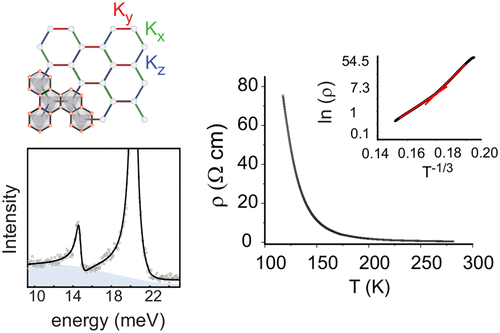当前位置:
X-MOL 学术
›
Nano Lett.
›
论文详情
Our official English website, www.x-mol.net, welcomes your feedback! (Note: you will need to create a separate account there.)
Electrical Transport Signature of the Magnetic Fluctuation-Structure Relation in α-RuCl3 Nanoflakes
Nano Letters ( IF 10.8 ) Pub Date : 2018-04-10 00:00:00 , DOI: 10.1021/acs.nanolett.8b00926 Soudabeh Mashhadi 1 , Daniel Weber 1 , Leslie M. Schoop 1 , Armin Schulz 1 , Bettina V. Lotsch 1 , Marko Burghard 1 , Klaus Kern 1, 2
Nano Letters ( IF 10.8 ) Pub Date : 2018-04-10 00:00:00 , DOI: 10.1021/acs.nanolett.8b00926 Soudabeh Mashhadi 1 , Daniel Weber 1 , Leslie M. Schoop 1 , Armin Schulz 1 , Bettina V. Lotsch 1 , Marko Burghard 1 , Klaus Kern 1, 2
Affiliation

|
The small gap semiconductor α-RuCl3 has emerged as a promising candidate for quantum spin liquid materials. Thus far, Raman spectroscopy, neutron scattering, and magnetization measurements have provided valuable hints for collective spin behavior in α-RuCl3 bulk crystals. However, the goal of implementing α-RuCl3 into spintronic devices would strongly benefit from the possibility of electrically probing these phenomena. To address this, we first investigated nanoflakes of α-RuCl3 by Raman spectroscopy and observed similar behavior as in the case of the bulk material, including the signatures of possible fractionalized excitations. In complementary experiments, we investigated the electrical charge transport properties of individual α-RuCl3 nanoflakes in the temperature range between 120 and 290 K. The observed temperature-dependent electrical resistivity is consistent with variable range hopping behavior and exhibits a transition at about 180 K, close to the onset temperature observed in our Raman measurements. In conjunction with the established relation between structure and magnetism in the bulk, we interpret this transition to coincide with the emergence of fractionalized excitations due to the Kitaev interactions in the nanoflakes. Compared to the bulk samples, the transition temperature of the underlying structural change is larger in the nanoflakes. This difference is tentatively attributed to the dimensionality of the nanoflakes as well as the formation of stacking faults during mechanical exfoliation. The demonstrated devices open up novel perspectives toward manipulating the Kitaev-phase in α-RuCl3 via electrical means.
中文翻译:

在磁波动,结构关系的电气交通运输签名α-的RuCl 3纳米片
小的间隙半导体α-的RuCl 3已经作为量子自旋液体材料有希望的候选。迄今为止,拉曼光谱,中子散射和磁化测量已经提供了一种用于在α-的RuCl集体自旋行为有价值的提示3块状晶体。然而,实现α-的RuCl的目标3到自旋电子器件会强烈从电探测这些现象的可能性受益。为了解决这个问题,我们首先研究了纳米薄片α-的RuCl 3通过拉曼光谱法观察到的行为与散装材料类似,包括可能的分级激发的信号。在互补实验中,我们调查个体的电荷传输性α-的RuCl 3纳米片的温度范围介于120到290 K之间。观察到的随温度变化的电阻率与可变的跳频行为一致,并且在约180 K处表现出转变,接近我们在拉曼测量中观察到的起始温度。结合整体中结构与磁性之间的已建立关系,我们将这种转变解释为与纳米薄片中Kitaev相互作用引起的分次激发的出现相吻合。与散装样品相比,纳米片中潜在结构变化的转变温度更高。暂时将该差异归因于纳米薄片的尺寸以及机械剥落过程中堆积缺陷的形成。3通过电气方式。
更新日期:2018-04-10
中文翻译:

在磁波动,结构关系的电气交通运输签名α-的RuCl 3纳米片
小的间隙半导体α-的RuCl 3已经作为量子自旋液体材料有希望的候选。迄今为止,拉曼光谱,中子散射和磁化测量已经提供了一种用于在α-的RuCl集体自旋行为有价值的提示3块状晶体。然而,实现α-的RuCl的目标3到自旋电子器件会强烈从电探测这些现象的可能性受益。为了解决这个问题,我们首先研究了纳米薄片α-的RuCl 3通过拉曼光谱法观察到的行为与散装材料类似,包括可能的分级激发的信号。在互补实验中,我们调查个体的电荷传输性α-的RuCl 3纳米片的温度范围介于120到290 K之间。观察到的随温度变化的电阻率与可变的跳频行为一致,并且在约180 K处表现出转变,接近我们在拉曼测量中观察到的起始温度。结合整体中结构与磁性之间的已建立关系,我们将这种转变解释为与纳米薄片中Kitaev相互作用引起的分次激发的出现相吻合。与散装样品相比,纳米片中潜在结构变化的转变温度更高。暂时将该差异归因于纳米薄片的尺寸以及机械剥落过程中堆积缺陷的形成。3通过电气方式。



























 京公网安备 11010802027423号
京公网安备 11010802027423号